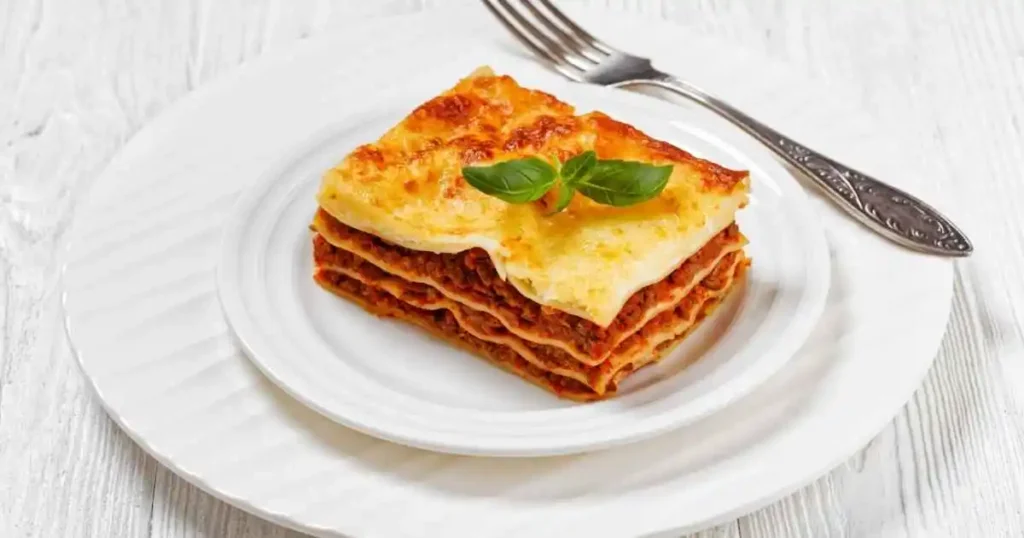As an Italian-American, I’ve always loved the rich flavors of classic lasagna. But it wasn’t until I visited my family in Bologna that I learned the real way to make it. The secret? They use béchamel sauce instead of ricotta cheese.
The traditional Italian lasagna from Bologna has a velvety béchamel sauce. It’s layered with savory bolognese ragu, grated Parmigiano-Reggiano, and delicate lasagna noodles. This makes the dish smooth and luxurious, perfect for the bold meat flavors. It’s a culinary masterpiece that takes you straight to Italy’s heart.
Whether you love cooking at home or exploring new foods, making classic Italian-style lasagna without ricotta is a must. With the right techniques and ingredients, you can make this iconic comfort food in your kitchen. Get ready for a flavorful journey through Italian traditions.
Understanding Traditional Italian Lasagna
Authentic Italian lasagna comes from Bologna, Italy. It’s a dish with a perfect mix of flavors. It has homemade bolognese ragu, creamy béchamel sauce, and aged Parmigiano-Reggiano cheese. Unlike American lasagna, it doesn’t use ricotta but instead béchamel for its velvety texture.
1.The Origins of Authentic Italian Lasagna
Authentic Italian lasagna comes from Emilia-Romagna in northern Italy. It’s a dish loved for centuries. The recipe uses slow-cooked meat ragu, made with 93% lean ground beef and Italian sausage. It’s layered with lasagna noodles and a creamy béchamel sauce made with 2% milk.
2.Why Béchamel Instead of Ricotta
Choosing béchamel over ricotta is a deliberate choice. It aims to make the dish creamy and balanced. Béchamel’s smooth texture and rich flavor go well with the bold ragu. Ricotta can make the dish feel too heavy.
3.Key Components of Classic Italian Lasagna
The key parts of classic Italian lasagna are:
- Homemade bolognese ragu, simmered for about 2 hours to develop deep, complex flavors
- A luscious béchamel sauce, thickening in 5-7 minutes
- Freshly grated Parmigiano-Reggiano cheese
- 12 lasagna sheets, either fresh or dried, cooked al dente
This mix of ingredients makes a balanced and authentic Italian lasagna. Every bite is creamy but not too heavy, staying true to the classic flavors.
Essential Ingredients for Lasagna Without Ricotta
Making a classic Italian lasagna without ricotta cheese needs the right ingredients. The key parts are the bolognese ragu, béchamel sauce, and lasagna noodles. These elements make the dish a true comfort food.
1. Building the Bolognese Ragu
The base of a real Italian lasagna is a rich bolognese ragu. It’s made with soffritto (chopped onion, celery, and carrot), ground beef, pork sausage, red wine, tomato sauce, milk, and herbs. Cooking it slowly blends the flavors perfectly.
2. Crafting the Béchamel Sauce
A creamy béchamel sauce replaces ricotta in this lasagna Without Ricotta. It’s made by mixing butter, flour, and milk until smooth. This sauce adds creaminess and holds the lasagna layers together.
3. Selecting the Lasagna Noodles
The right pasta is crucial for a complete lasagna. Fresh, hand-rolled noodles are ideal, but good dried lasagna sheets work too. Choose a brand that cooks up soft and pliable for easy layering.
4. Cheese Alternatives
For a dairy-free lasagna, you’ll need cheese substitutes. Grated Parmigiano-Reggiano or vegan “parmesan” can add the savory taste you want. With these ingredients, you’re ready to make a delicious, authentic lasagna.
| Ingredient | Quantity |
|---|---|
| Lasagna Noodles | 14 sheets |
| Onion | 1 cup, chopped |
| Garlic | 3-4 cloves, minced |
| Crushed Tomatoes | 1 (28 oz) can |
| Olive Oil | 2 tablespoons |
| Parmigiano-Reggiano or Vegan Parmesan | As needed for layers |
The Perfect Bolognese Meat Sauce
Making the ultimate bolognese sauce is key to a great Italian lasagna Without Ricotta. It uses ground beef and pork sausage for a rich flavor. Let it simmer for at least an hour to blend the herbs and spices perfectly.
1.Choosing the Right Meat Blend
The secret to a real bolognese sauce is the meat mix. Ground beef and pork sausage give it a unique taste. The pork adds a sweet touch that goes well with the beef, making the sauce rich and satisfying.
2.Herbs and Seasonings for Depth
Enhance your bolognese sauce with fresh herbs and spices. Basil, oregano, and garlic are must-haves for a true Italian taste. A bit of red wine or Chianti also adds to the sauce’s richness.
3.Simmering Times and Techniques
For the best taste, let your bolognese sauce simmer for at least an hour. But, for even more flavor, cook it for up to three hours. This slow cooking makes the sauce smooth and full of taste. Stir it now and then and keep the heat low.
Homemade bolognese sauce is the heart of a classic Italian lasagna. By making the perfect meat sauce, you’ll make your lasagna even better. It’s perfect for any family dinner dishes or a cozy night at home.
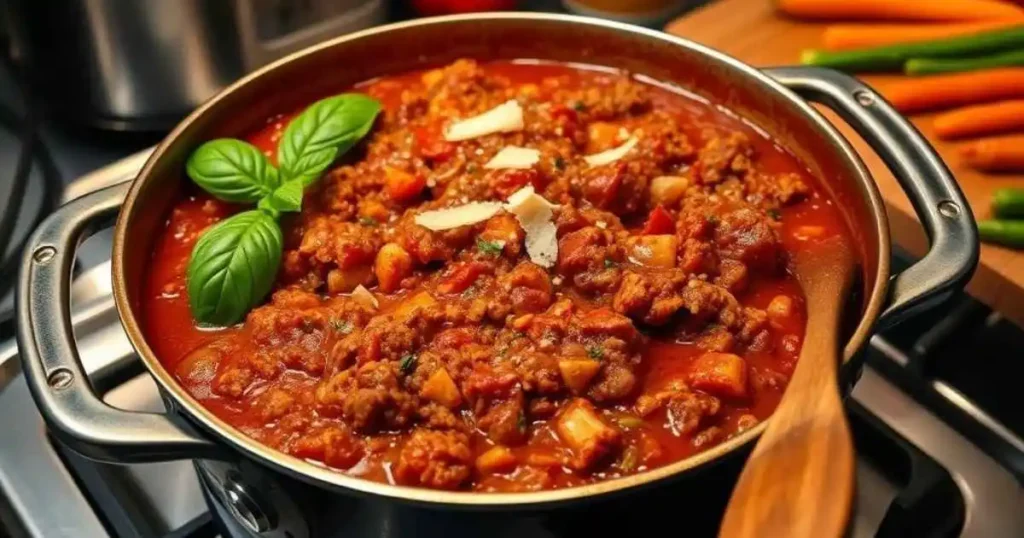
Mastering the Béchamel Sauce
Béchamel sauce is key to traditional Italian lasagna Without Ricotta. It’s made with butter, flour, and milk. This creates a creamy texture that goes well with pasta, meat, and cheese.
To make the perfect homemade béchamel sauce for your white sauce for lasagna, start by melting butter in a saucepan over medium heat. Then, whisk in an equal amount of flour to make a roux. Slowly add warm milk, whisking all the time to avoid lumps. Keep stirring until it thickens into a creamy creamy lasagna sauce.
Seasoning is crucial to enhance the béchamel’s flavor. Add a pinch of nutmeg, salt, and freshly ground black pepper. For a dairy-free version, use plant-based milk and vegan butter substitutes.
With a bit of practice, you’ll get the hang of making a rich and creamy homemade béchamel sauce. It will elevate your lasagna without ricotta to new levels of comfort food.
Choosing the Right Lasagna Noodles
Choosing the right noodles is key to a perfect lasagna without ricotta. There are many types, including fresh, dried, and no-boil options. Knowing the pros and cons of each helps pick the best for your lasagna.
1. Fresh vs. Dried Pasta Options
Fresh lasagna noodles have a better texture and taste. They are tender but firm, which goes well with the dish’s layers. But, they need boiling and careful handling to avoid tearing.
Dried lasagna noodles are easier to use. They can be layered straight from the box without boiling.
2. No-Boil Noodles Tips
No-boil lasagna sheets save time by not needing pre-cooking. They soak up moisture during baking. But, make sure to cover them well with fresh pasta for lasagna sauce to prevent drying.
You might need to adjust baking times and temperatures for no-boil noodles. This ensures they cook right.
It’s important to cook all lasagna noodles until they’re al dente. This way, they’ll soften more during baking. With the right noodles and preparation, your lasagna without ricotta will look great and taste amazing.
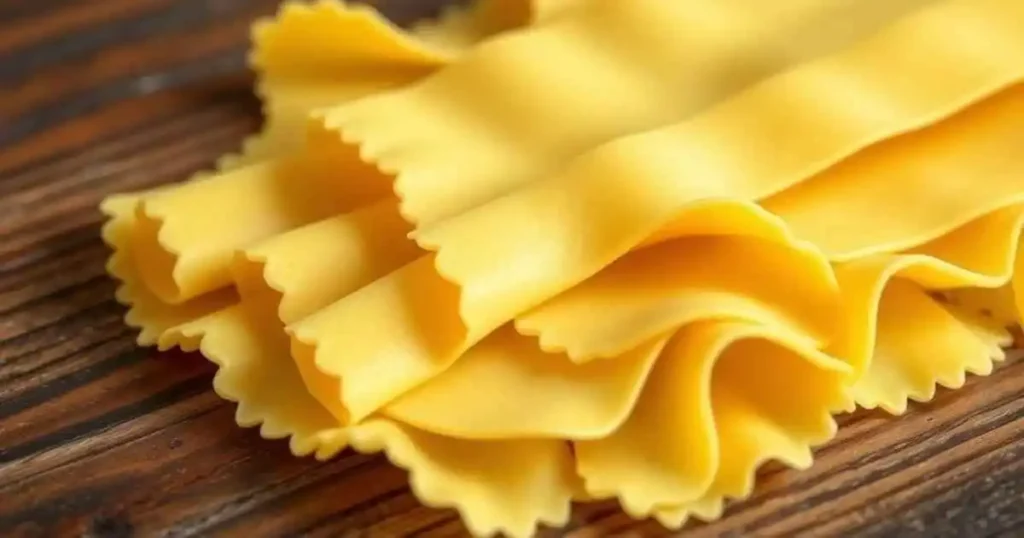
Cheese Selection and Combinations
Choosing the right cheese for lasagna is key. Italian recipes often use Parmigiano-Reggiano for its bold, nutty taste. But, you can also try other cheeses to make your lasagna creamier and deeper.
Adding mozzarella in lasagna makes it gooey and melty. Its mild taste goes well with the sharp Parmigiano-Reggiano.
- Try other hard, aged cheeses like Pecorino Romano or Asiago for different flavors in your lasagna.
- For a dairy-free choice, use vegan almond parmesan or nutritional yeast to get a cheesy taste without the dairy.
Finding the right cheese mix is crucial for a great lasagna. Experiment with different cheeses and amounts to match your taste.
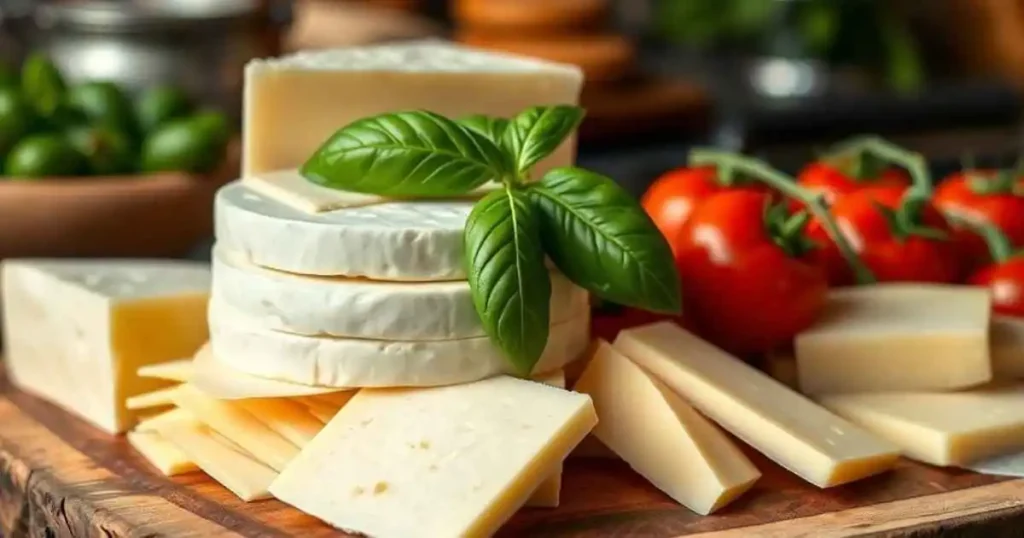
Layer-by-Layer Assembly Guide
Making the perfect lasagna without ricotta is all about how you put it together. Start by spreading a thin layer of your tasty Bolognese meat sauce at the bottom of your baking dish. This helps prevent the noodles from sticking.
1. Base Layer Preparation
Place your lasagna noodles in a single layer, making sure they cover the whole surface. This step is crucial, whether you’re using fresh or dried pasta. It lays the groundwork for your lasagna assembly.
2. Creating Perfect Layers
- Spread a layer of creamy béchamel sauce over the noodles.
- Then, add a layer of your flavorful Bolognese meat sauce on top, spreading it evenly.
- Next, sprinkle a layer of cheese, like mozzarella and Parmigiano-Reggiano, for that amazing cheese pull.
- Keep repeating these layers until you’ve used up all your ingredients, aiming for 5-6 distinct lasagna layers.
3. Top Layer Finishing
For the last layer, cover your lasagna with a lot of béchamel sauce and a generous sprinkle of Parmigiano-Reggiano cheese. This will give you a beautifully browned, crispy top that locks in all the flavors.
By using this layering technique, you’ll get the classic lasagna without ricotta structure and a perfectly balanced flavor in every bite.
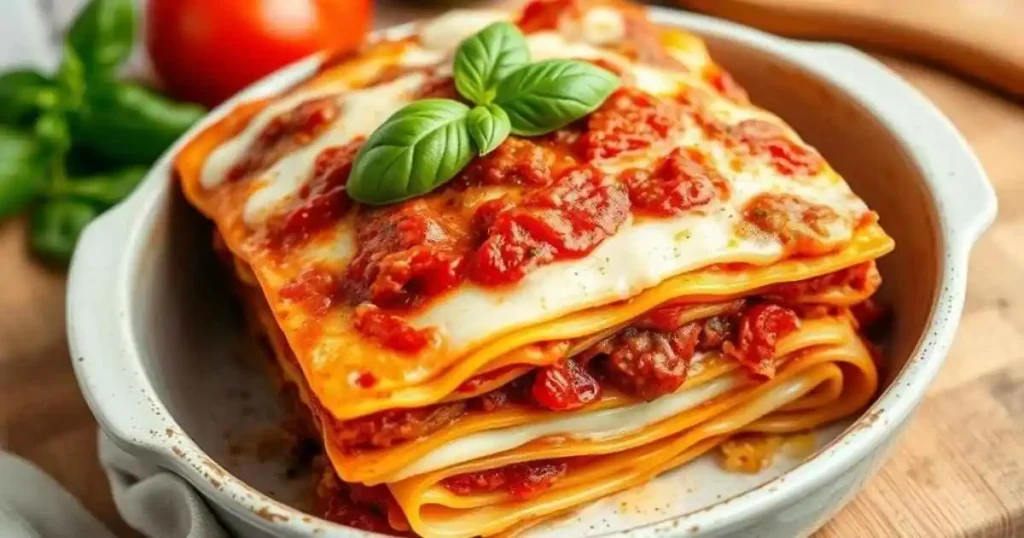
Baking Times and Temperatures
Getting the baking time and temperature right is key to a tasty lasagna. To make a classic Italian-style lasagna without ricotta perfectly, just follow these easy steps.
First, preheat your oven to 375°F (190°C). This temperature is perfect. It makes sure the lasagna’s layers are well heated and the top gets golden and bubbly.
Next, cover the lasagna with aluminum foil and bake for 25 minutes. This step helps the flavors mix and the noodles get tender. After that, take off the foil and bake for another 20-25 minutes. This makes the top golden brown and the edges bubbly.
Your baking lasagna should cook for about 45-50 minutes. This lasagna cooking time ensures the perfect lasagna temperature. It turns the layers into a delicious, harmonious dish.
After baking, let the lasagna rest for 10-15 minutes before serving. This resting time helps the layers set. It makes cutting and serving neat, tidy slices easier.
| Baking Step | Temperature | Time |
|---|---|---|
| Covered Baking | 375°F (190°C) | 25 minutes |
| Uncovered Baking | 375°F (190°C) | 20-25 minutes |
| Total Baking Time | 375°F (190°C) | 45-50 minutes |
| Resting Time | N/A | 10-15 minutes |
By following these baking lasagna tips, you’ll get the perfect lasagna temperature and lasagna cooking time. You’ll enjoy a delicious, homemade Italian-style comfort food classic.
Dairy-Free Alternatives for Lasagna Without Ricotta
It’s easy to make a creamy lasagna without dairy. Plant-based options let you enjoy the taste and feel of classic lasagna. This is great for those who follow special diets or have dietary restrictions.
A homemade cashew cream is a great substitute for ricotta and béchamel sauce. To make it, blend 2 cups of raw cashews with water, lemon juice, nutritional yeast, salt, and garlic powder until it’s smooth and creamy.
For a vegan Parmesan cheese topping, mix finely ground hemp seeds, nutritional yeast, garlic powder, and onion powder. This blend gives a savory, umami flavor that’s perfect for your vegan lasagna or dairy-free lasagna.
Choose a high-quality plant-based lasagna recipes for the marinara sauce. Or, make your own by simmering crushed tomatoes, herbs, and seasonings on the stovetop.
With these dairy-free ingredients, you can make a vegan lasagna or dairy-free lasagna that’s just as good as the traditional one. And it’s all without any animal products.
Storage and Reheating Tips
Homemade lasagna without ricotta can be enjoyed for days, not just the first time. Proper storage and reheating keep the flavors alive. Whether you’re saving leftovers or freezing a batch, these tips ensure quality and taste.
1. Freezing Instructions
To freeze your lasagna without ricotta for later, follow these steps:
- Let the lasagna cool completely after baking.
- Slice it into portions and wrap each in aluminum foil.
- Put the wrapped slices in airtight bags or containers, removing air.
- Frozen lasagna stays good for up to 3 months.
2. Optimal Reheating Methods
Ready to enjoy your frozen lasagna? Here’s how to do it right:
- Thaw it in the fridge overnight.
- Preheat your oven to 350°F (175°C).
- Take the lasagna out of the foil or container and put it in a dish.
- Cover it with foil and bake for 45-60 minutes. It should be hot and reach 165°F (74°C).
- For quicker reheating, microwave individual portions for 2-3 minutes, checking often.
These storage and reheating tips let you enjoy homemade lasagna without ricotta long after the first meal. Whether freezing extra or reheating leftovers, these methods keep the flavor and texture perfect.
I’m delighted to share this lasagna without ricotta with you, with the hope it becomes a favorite in your routine.
Common Mistakes to Avoid
When making the perfect lasagna without ricotta, there are a few mistakes to avoid. One big mistake is using too little sauce. Make sure you have enough sauce, especially with no-boil noodles, to keep it moist.
Another mistake is overcooking the noodles. Cook them until they’re al dente, as they will soften more in the oven. If the noodles are too soft, your lasagna will be mushy.
Finally, don’t cut into the lasagna right away. Wait 10 to 15 minutes after baking. This lets the layers firm up and the flavors blend. Cutting into it too soon can make it messy.
Frequently Asked Questions
What is the difference between traditional Italian lasagna and Italian-American versions?
Traditional Italian lasagna uses béchamel sauce, not ricotta cheese. This makes it smooth and velvety. It pairs well with pasta and meat sauce.
Where does authentic Italian lasagna originate from?
It comes from Bologna. It’s made with bolognese ragu, béchamel sauce, Parmigiano-Reggiano cheese, and lasagna noodles.
What are the key components of classic Italian lasagna?
Classic Italian lasagna has homemade bolognese sauce, béchamel sauce, Parmigiano-Reggiano cheese, and lasagna noodles. This mix gives a rich flavor and smooth texture.
How do you make the perfect bolognese sauce for Italian lasagna?
Use ground beef and pork sausage for flavor. Add fresh basil, oregano, and garlic. Simmer it for at least an hour to blend flavors.
What is the role of béchamel sauce in Italian lasagna?
Béchamel sauce is key. Made with butter, flour, and milk, it adds creaminess and flavor to the dish.
What type of lasagna without ricotta noodles should you use?
Choose between fresh and dried noodles. Fresh noodles are better but need more prep. Dried noodles are easy to find. No-boil noodles save time but need more sauce.
What cheese is typically used in traditional Italian lasagna?
Parmigiano-Reggiano is the main cheese. Mozzarella can be added for creaminess. Parmigiano-Reggiano adds a sharp, nutty taste.
How do you assemble the perfect lasagna without ricotta?
Start with a thin meat sauce layer to prevent sticking. Then, layer noodles, béchamel sauce, meat sauce, and cheese. Repeat until you run out of ingredients. Top with béchamel and Parmigiano-Reggiano.
What temperature and baking time is recommended for lasagna without ricotta ?
Preheat to 375°F (190°C). Cover with foil for 25 minutes. Then, remove foil and bake for 20-25 minutes more. Total time is about 45-50 minutes.
How can I make a dairy-free lasagna without ricotta?
Use soy milk or plant-based alternatives in the sauces. Replace butter with vegan substitutes. Use vegan parmesan or nutritional yeast instead of Parmigiano-Reggiano.
How should I store and reheat leftover lasagna without ricotta?
Keep it in an airtight container in the fridge for 3-4 days. Freeze individual slices for up to 3 months. Thaw overnight and reheat at 350°F (175°C) until warm.
What are the common mistakes to avoid when making lasagna without ricotta ?
Avoid using too little sauce and overcooking noodles. Let the lasagna without ricotta for 10-15 minutes after baking. This helps the layers set.

